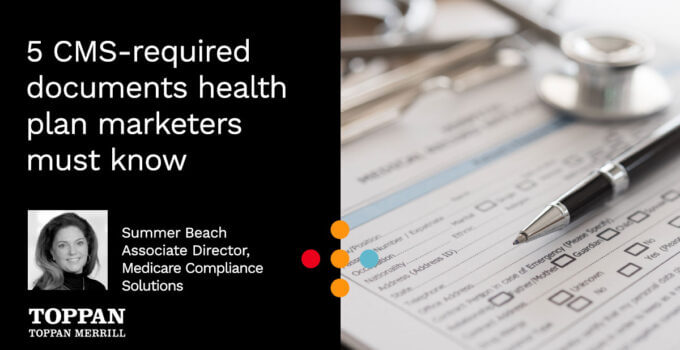Navigating the modern requirements and insurance documents of Medicare insurance can be a complex and a demanding task for many health plans because of the many moving parts and the regulations that can change at a moment’s notice. This is why it’s important to understand the exact purpose and requirements of model documents.
In this piece, we discuss what a formulary is and highlight the importance of other documents required by the Centers for Medicare & Medicaid Services (CMS), for Medicare Advantage and Part D plans. Certain required documents are model-based, and others are not. However, each must be created for their associated plan and “plan type.”
What is a Formulary?
A formulary, or drug list, identifies medications covered within the health plan and is based upon a model provided by CMS. This drug list is continually updated and reviewed by doctors, pharmacists, physicians and other health care experts.
The health plan presents an abridged, or comprehensive, formulary. The abridged formulary is a shorter version of this medication list, and the comprehensive formulary is a complete version of the medication list. Members may call their health plan to verify if the plan covers their medication, if they do not see it listed.
The CMS-approved formulary contains medications eligible under a plan’s drug benefits. The formulary also outlines any additional drug coverage requirements or limits, for generic and brand name medications and includes types of medications that are excluded from coverage. Some plans list drugs that are not covered by a Medicare Part D plan, called “Extra Covered Drugs” or “Supplemental Benefits.” These medications are displayed on a separate list within the formulary document.
Formulary drug tiers
The formulary is generally categorized in tiers, which are coverage groupings and classifications for the variety of drugs covered. These tiers are determined by the following:
Drug tiers and their classifications:
• Generic
• Preferred Generic
• Brand
• Preferred Brand
• Non-preferred Brand
• Specialty
The number of drug tiers offered by a plan ranges from 3 to 6. Plans label these tiers according to the name of the tier, and/or the tier’s number, which ranges from 1 to 6.
Each tier includes specific types of medications, and their pricing levels Tier 1 drugs generally consist of lower-cost generic drugs, while tiers 5 or 6 usually include the most expensive category of specialty drugs. The beneficiary’s out-of-pocket cost can range from a smaller copay per prescription (such as in tiers 1 and 2), to a percentage of the overall drug’s cost in more expensive tiers (such as in tiers 5 and 6).
The number and formatting of drug tiers can vary, depending on the insurance carrier’s approved benefit structure.
Standardized model documents
The formulary is based on a model document issued by Centers for Medicare &Medicaid Services (CMS). Model documents are standardized documents that include criteria which all Medicare Advantage and Part D health plans are required to follow when they develop their formularies, and if their plan includes drug coverage.
The standardized criteria of model documents help ensure all the drug categories are presented uniformly. This helps members understand their coverage and helps potential plan members compare the possible out-of-pocket costs between plans.
Formulary guidance
In recent years, CMS has given health plans the option of posting their formularies online or in an abridged hard-copy version. Per CMS, if an abridged version of a formulary is sent to members, then a distinct and separate notice (in hard copy) should describe where beneficiaries can find the comprehensive formulary online, and how to request a hard copy comprehensive formulary.
This flexibility helps health plans save printing and postage costs when distributing hard copies of the formularies.
What is a Summary of Benefits?
As the name suggests, a Summary of Benefits (SB) is a document that accurately describes the plan’s benefits. The SB is required by CMS and contains a snapshot of health care coverage, costs and benefits. The SB typically includes uniform definitions of standard medical terms, the exceptions and limitations of the coverage, and coverage examples.
The SB helps customers compare plans and understand what is and is not covered by the insurers. The SB is heavily used by sales teams to educate potential plan members about various options. SB documents contain a disclaimer to ensure potential members understand the full plan details are available in the Evidence of Coverage (EOC), since the SB doesn’t include all benefits or details. For this reason, sales representatives should have the EOC document ready for use to pair with the SB in sales discussions.
Although the SB has specific rules regarding a minimum list of benefits to include, and a prescribed order of appearance for the content, it is technically not a model document, which gives health plans some flexibility in terms highlighting additional services. This means plans can get a little more creative in the verbiage, illustrations and pictures used.
However, plans must still meet the minimum requirements and include all of the relevant information regarding inclusions, such as contact information and costs. Where relevant, CMS-required disclaimers must also be used to explain benefits in more precise terms and to eliminate any ambiguity.
This can be particularly tricky for some health plans that must strike a balance between promoting their services and explaining its plan benefits in an accurate and comprehensive way.
What is a Summary of Benefits & Coverage?
The Summary of Benefits & Coverage (SBC) serves nearly the same purpose as the Summary of Benefits, with one key difference. The SBC is a document specific to plans under the Affordable Care Act (ACA), and it has its own format. Unlike the SB, the SBC does follow an exact model, which means that it should follow the precise wording guidelines, format and marketing guidance defined by CMS.
Health plans creating SBC documents should familiarize themselves with the requirements defined by CMS, and plans may benefit from developing a checklist based on CMS regulations to ensure nothing is missed during the plan’s various edits and revision stages.
What are Provider Directories?
A Provider Directory is a list of physicians, hospitals and in-network providers who deliver medical care in the plan’s network. Although not all plans have a network, most health plans have negotiated rates with contracted professionals.
Some plans offered by insurers only cover services conducted by professionals that are listed in their provider network. Other plans may offer “out-of-network” benefits, which means services will be covered at a lower cost when obtained outside the plan’s provider network.
Under CMS rules, health plans are legally required to provide an online and hard copy of these directories upon request.
One of the biggest challenges many plans face, is keeping the provider directories accurately updated. For example, a health care professional may leave the plan’s network before the document update is completed, or new providers may join the network immediately afterward.
According to the CMS Online Provider Directory Report 52.20% of the provider directory locations listed had at least one inaccuracy. Some of the most common errors noted are providers not at the location listed, provider contact details were incorrect, or providers were not accepting new patients even though the directory suggests that are open to new patients.
Because of these issues occurring year-over-year, guidelines now require health plans to conduct monthly provider directory audits. Verifying and then sharing provider information can be an administrative burden, and many health plans are still resorting to manual processes to validate details, including calling all providers individually.
One organization is trying to reduce this administrative burden by creating a centralized platform that gives health plans an accurate and unified way to find all the providers that are within the various networks of California. The Integrated Healthcare Association (IHA) is creating the Symphony Provider Directory. As a single source of truth, this innovation will ideally support health care professionals in sharing and updating their data to a platform where the information can be accurately distributed to health plans, essentially creating a centralized accessible directory for participating plans and potentially their enrollees.
The Symphony Provider Directory pilot project, if successful, could lead to similar efforts across the United States which may ultimately reduce the cost and administrative burden for plans, alleviate the hassle and manpower of manually contacting providers every month, and enable plan providers to share accurate information with plan members.
What are Pharmacy Directories?
A pharmacy directory outlines the network of pharmacies covered in the health plan. Plans may have different pharmacy tiers in their network including preferred pharmacies, non-preferred pharmacies and non-network/out-of-network pharmacies. Pharmacy directories must be updated monthly.
Pharmacy directories and provider directories are similar in many ways and health plans may choose to provide a pharmacy directory as a separate document or combine it with the provider directory. Plans that only provide medical services, or conversely only provide drug coverage, generally do not distribute a combined directory.
How Toppan Merrill can help
Toppan Merrill helps insurers manage and update CMS model documents, including the Evidence of Coverage (EOC) and Annual Notice of Change (ANOC) by offering teams a single source of truth for the latest templates, approved assets, data and tools to ensure consistency and maintain compliance.
Our platform facilitates seamless transitions from print to electronic communications and helps plan providers respond quickly to regulatory changes, client needs and markets. We offer a number of services including omnichannel communications, document creation and management, sales enablement, printing services and additional services to ensure you can quickly respond to the changing environment. To learn more about our services, and how we support our partners on model documents, at the Toppan Merrill website.



